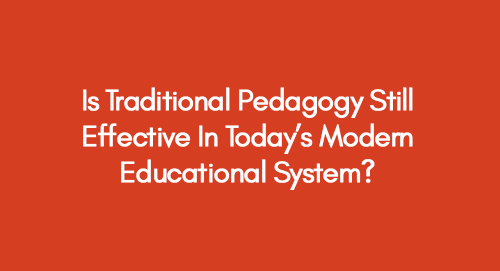
The Impact of Airport Terminal Expansion on Customer Services
December 13, 2022
The Impact of Corporate Governance on Financial Performance of SMEs: A Case of SMEs in the Retail Industry in Nairobi CBD
December 13, 2022Although cognitive theory is often considered a complex notion, the fundamental idea underlying the theory is rather simple. It states that human development is a function of the overall interaction and personal experiences between a person and the environment. Nonetheless, cognitive theorists tend to focus more on things that are rather intangible (Arends, 2014). Parkay, Anctil and Hass (2014) argued that cognitive theorists concentrate more on internal processes for knowledge development. These processes are impossible to observe and are based on inferences directly. Human development is directly connected with education, and pedagogical debate has a significant amount of research based on social cognitive theory and how children learn and can be taught. There has been considerable debate about cognitive learning and social cognition and its role in educational pedagogy. This essay aims to critically analyse Bruner’s ideas about social cognition and compare them to modern social cognitive theories to assess the effectiveness of implementing traditional pedagogy in modern education systems. This essay begins with a brief explanation of Bruner’s ideas and theories and then continues to analyse the role of modern theories in existing education pedagogy. Simultaneously, this essay compares Bruner’s ideas with theories related to joint attention, imitation, theory of mind, and intentionality and assesses whether Bruner’s ideas are consistent. Overall the essay concludes whether there is consistency and if there is still relevance of traditional pedagogy in modern education.
 Download PDF File
Download PDF File
Discussion
Bruner’s Ideas and Social Cognition
The cognitive theory put forward by Bruner focused on the impact of experiential and environmental factors in the development and education of a child. This theory suggests that every child develops intellectual ability in various stages and shows how a child changes using the mind. Bruner argued that children need to learn principles and notions, or the structure of ideas, instead of simply memorising facts and information for children's development. He argued that the education and learning of children regarding any subject in their early years should encourage children to use their intuitive grasping to understand fundamental ideas. Bruner argued that when children grow, there is a need to revise the curriculum while accounting for already learned ideas, focus on expanding previous learning and gradually increase complete comprehension of each idea, and teach them interconnection between various ideas. This phenomenon, as Bruner calls is known as the “spiral curriculum”. It presents ideas in repeated learning opportunities for a given period. They are organized from simple to complex ideas, from generic to more specific ideas, and then focus on interaction and relationship between ideas. This is a spiral fashion of arrangement of information to be taught to children. Bruner argued that it helps children to ensure the knowledge gained is organised through a structure, and thus they can use structured information in a more useful and accessible manner. Several significant influences were observed while implementing this traditional pedagogy in modern education practices in that era. Following are the main ideas of this theory and how they were applied in the educational pedagogy context (Kolb, 2014):
- Children learn through an active process, and they select and transform ideas and information.
- Children make decisions and develop hypotheses to test effectiveness.
- The experience of children is fundamental in organising information with already existing knowledge.
- Peers and adults can provide support for learning through scaffolding; the support gradually diminishes as children grow.
- There are three stages of intellectual development. First is the enactive stage, in which children learn through actions. The second is an iconic stage in which children use pictures and models to understand. The third is the symbolic stage, in which children develop the ability to think and analyse abstract ideas.
- There is a need to revise the curriculum and expand previously delivered knowledge.
- Children’s learning is affected by extrinsic motivation, yet only in the short run, and intrinsic motivation is more efface for children’s learning development
The aforementioned key points had a significant impact on educational practices, which are reflected in the following (Neisser, 2014):
- Teachers must develop instruction according to learners’ level. Teachers need to evaluate the learning modes of learners (enactive, iconic, symbolic) to plan and prepare adequate educational material and instructions.
- Teachers need to revise the curriculum for knowledge enhancement based on pre-taught ideas to let children grasp full and more complex ideas based on previously learnt simple ideas. Teachers need to organise grammar points, vocabulary, and other topics to encourage learners to develop deeper comprehension and elongate retention.
- There should be a sequence to present the material:
- For the acquisition and construction of knowledge,
- Transformation and transfer of learning.
- Teachers should involve students in using previous structures and experiences with new concepts.
- Teachers should help students to organise further information with previous knowledge in a structured way.
- Teachers need to help learners in knowledge development. The assistance increasingly diminishes to promote intrinsic motivation.
It is important to note that this theory emphasises the role of the teacher as a critical component, as teachers are responsible for organising lessons to ensure that children receive information in a structured format. Thus it can be inferred that this theory promotes the implementation of traditional pedagogy in modern education system, where education is based on the directed flow of information from teacher to student. It can also be defined as the ‘pre-technology education context’ in which the role of the teacher is critical for the educational attainment and quality of education. The teacher is the source of knowledge and the educational material, and students are simply receivers of knowledge and information. Traditional pedagogy is typically based on fixed deadlines, pre-packaged learning materials, teacher-determined criteria for learning and assessment conducted by teachers.
So far, this essay has shown that Bruner’s ideas about education of learning favour traditional pedagogy. This essay now turns its attention to modern social cognition theories and their application in education and pedagogy to assess whether the ideas of Bruner are consistent with modern theories or not.
Joint Attention
The notion of Joint attention (JA) can be described as the ability of children to coordinate visual attention with another child or adult, also called the social partner. It is important to note that most of the studies conducted on joint attention are based on children's infant stage. This is because the collective attention phenomenon is more observable at this stage. The research indicates that JA is a necessary component of social attention that emphasises its role in the cognitive activities of the child and how they affect children's learning. Much empirical evidence indicates that joint attention is pivotal for infant learning, social-cognitive development, and language development, particularly in the early years of life (Lieberman, Hatrak, and Mayberry, 2014). Joint attention has been identified as a significant predictor of cognitive outcomes and social competence in a typically developing child. It is also considered to be an important factor in neurodevelopmental disorders. In addition, the latest research indicates that various measures of joint attention can be used as a unique source of information regarding variation in children's performance in school, particularly in preschool children. Thus it can be inferred that joint attention has a significant relationship with cognitive and social outcomes in the case of preschool children. Joint attention helps in children's social learning (Mundy, 2016).
The difference in children's joint attention measures is likely related to social motivation. They reflect the desire of a child to share attention and experiences and positively impact communication with others. Thus it can be inferred that the individual differences in joint attention scores are predictors of social motivation, and they reflect the development of the ability of children to interact with adults and peers positively. They also predict a child's social competence development (Bialystok, 2015). Furthermore, research also indicates that joint attention is used as a marker for infants regarding their evolution of social cognition. Joint attention is achieved through gestures, eye contact, and facial expressions to share experiences and information. In the case of preschool and school-aged children, the development of social cognition has a direct relationship with their cognitive and behavioural outcomes. Thus it can be confirmed that joint attention parameters and measures are the links between children’s social cognitive development and their behaviour regarding learning (Moore, 2014).
Furthermore, according to Rowell (2015), joint attention is also related to executive functions in a child. They involve regulating attention and self-monitoring, which are critical for children's cognitive and social development. For example, according to Koyama (2016), the difference in children's joint attention is linked with goal-directed or intentional actions, self-monitoring, inhibitory control, and attention regulation, which are important in children's learning. Children’s executive skills, such as self-regulation, have been identified as critical to developing their pro-social behaviour. Finally, according to Mundy(2017), significant evidence suggests that the quality and frequency of joint attention significantly impact the learning of toddlers and infants. These can predict subsequent learning regarding perceptions and emotions about adults and others in the environment. Thus it can be inferred that the emotional recognition of a child is integral and critical to their comprehension and learning process and affects their ability to interact with others successfully. Furthermore, these areas of development are also considered important in children's language development.
The notion of joint attention has been used extensively in the education of children with autism. Several empirical studies indicate that autism is a neurodevelopmental disorder and is reflected by extreme weakening in the development of joint attention skills in preschool children. Therefore, researchers conclude that developing collaborative attention skills is the basic idea for the pedagogy of children with autism. Focusing on the attention skills of autistic children, teachers and adults can help them in social-cognitive development (Pickard and Ingersoll, 2015). It has been recognised that children's social attention coordination and social attention processes determine the success of interactions between children and others and the degree of social competence of children, including infants and young children. Overall it can be inferred that if the collective attention capacity or skills of a child is compromised and the child lacks developing a common frame of reference with others such as peers or teachers, then the child is likely to lack capacity in various skills, which include language and learning (Gillespie-Lynch et al., 2015). Upon considering the significance of this theory, the necessity of implementing traditional pedagogy in the modern education system could be questioned.
There is also significant research that shows that joint attention has a substantial relationship with language learning, particularly in terms of word learning. In children, early language acquisition is partly reflected by object naming and partly by recognition. The idea of word learning is related to joint attention because adults or peers use pointing gestures to develop a common point of reference with a child and teach the name and characteristics of any object. This action helps the child learn the name of the object and any instruction that the adult expects the child to follow. Previous research has extensively used this construct and shows that it is a well-defined approach to assessing word learning in children (Mundy et al., 2016). For instance, Pickard and Ingersoll (2015) conducted a series of studies of novel object recognition and concluded that infants increasingly use joint attention skills from age 5 to 9 months. After reaching nine months, children use joint attention for various other actions. For example, they use vocal cues and hand gestures. Furthermore, the study also showed that examinations of object recognition indicate that infants prefer looking and pointing at objects and use it as a social referencing component. Thus it indicates that children use social cues for future attention and recognition.
Overall the theoretical debate so far indicates that the joint attention construct can be used in pedagogy to promote learning in children. It is also used in the modern education system to promote the social development of children with autism. The role of the teacher is critical in implementing the notion of joint attention in pedagogy development for children, especially for pre-scholars and children with autism. The theory clearly indicates that pedagogy and curriculum should be developed according to the collaborative skills of learners. They can be manipulated to enhance the joint attention skills of children, which ultimately affects children's behaviour towards social partners and learning.
Modern pedagogy based on the use of modern technology, particularly ICTs, can be used as tools to develop a joint frame of reference and direct the children's attention towards the desired object. Yet, the role of the teacher remains critical for the use of modern technologies. Furthermore, modern technologies cannot measure or observe children's individual needs and tailor pedagogy regarding variation in the joint attention skills of learners. Thus the role of the teacher remains critical. Modern teachers can evaluate the weakness in joint attention skills of children in a class and then apply adequate strategies to promote learning in underachievers or children with autism. Therefore, the relevancy of traditional pedagogy in modern education can be fairly opined.
Imitation
One of the important forms of learning in children that manifests right from birth is learning by imitation. Wang, Williamson and Meltzoff (2015) concluded that infants, even one hour old infants, are able to imitate various gestures, such as mouth opening and tongue protrusion, as they watch adults or others manifesting the same gestures. However, when children reach the age of 9 months, their ability to manipulate new objects develops fast, and they start to imitate how others use objects, such as how babies imitate how others manipulate a toy. As children grow, they can even imitate actions that they watch performed by adults. Furthermore, children can imitate adults' activities, such as using a toy to make a sound or pressing a key of a keyboard or a toy to make a sound or start the music. Thus it can be inferred that an imitation is an important form of learning in children. Therefore educators can use it to instil desirable actions and behaviours in children in response to every situation (Meltzoff et al., 2017).
There are several positive impacts of imitation on the cognitive development of children. Children can imitate the precise actions of others to support and accelerate their cultural learning regarding arbitrary rituals and instrumental actions. Social routines and Instrumental innovations may reach other communities spread through imitation, ultimately, such behaviours may be transferred from one generation to the next, and thus they offer ample opportunities for cumulative progress (Wang, Williamson and Meltzoff, 2015). Another important benefit of imitation is its ability to increase learning opportunities. Even if children do not understand the acts completely, they can imitate them partially to discover cognitive understanding and deeper meaning of adults’ actions (Wobber et al., 2014).
The theory of connectionism indicates that, previously considered developmentally, a constant learning mechanism can yield special learning effects. For children, the quality of the learning environment is affected by the frequency of learning events experienced by children; thus, they are crucial for children’s acquisition of expertise (Marshall and Meltzoff, 2014). Teachers can use imitation to motivate learning in children. According to connectionist models, complex cognition may develop even without symbolic thought. The same can be observed in theory presented by Bruner, who stated that the inputs for children's cognitive development are partially internal and partially symbolic. The set of internal mediators is very important in the cognitive development of children as well as for language development. Children imitate adults to learn words, stories, and plays (Simpson et al., 2015).
Within the context of education, children's social recognition and cognitive development play an important role. The discussion above indicates that children imitate to learn objects, words, and stories and thus, teachers and adults can use this phenomenon to promote learning and knowledge development in children. The concept here is also interlinked with that of joint attention (Pickard and Ingersoll, 2015). Teachers and adults can use joint attention cues to focus the child's attention on a particular gesture or object and teach him/her about a response. Reversibly, teachers and adults can also identify certain words and gestures (joint attention cues) that children use to communicate with them and then deliver proper responses as feedback (Subiaul et al., 2016).
Again it can be inferred that the teacher's role remains critical for children's learning and cognitive development. Thus the notion of implementing traditional pedagogy in modern education requires that teachers are central to children learning and social development remains relevant for modern pedagogy.
Theory of Mind (ToM)
The theory of mind (ToM) refers to a causal explanatory framework developed by children to understand human behaviour. This framework helps them to understand psychological causality. Children learn about conditional probabilities and correlations that are embedded in human behaviour. For instance, they learn behaviour towards certain events to which people around them may respond with happiness or anger. They learn goal-directed actions, observe emotional responses and identify cause-and-effect relationships. Tom also shows how children follow gaze, infer intention or interest, and engage in joint attention with people around them. They share toys with peers and learn other social contingencies (Rabkina et al., 2017).
Using ToM, researchers understand children's mental states and thus make predictions about their behaviour, considering their desires and beliefs. For instance, if a child sees a person reaching for a certain object, such as a toy, the child may desire to imitate the action. This can be considered goal-directedness, that children's behaviour manifests in response to their experience with others.
Within the context of education, the most prominent example of the application of ToM is pretended play. For instance, teachers involve students in socio-dramatic role-play to help them understand social beliefs and societal values (Kristen and Sodian, 2014). Similarly, for children's language development, there is a meaningful discourse about how family and school play important roles in the earlier development of ToM children. The Theory of mind (ToM) encourages children to gain understanding and knowledge about teaching and learning processes in numerous facets, which include knowing what they do not know; understanding what other people know; knowledge that other people may not know about things that children know; and to understand how to gain knowledge about anything. ToM shows that children identify sources of information and knowledge, for example asking parents or teachers about unknown objects (Cavadel and Frye, 2017). ToM can be applied in education and pedagogy development in order to provide structured knowledge to children. This inference is consistent with Bruner’s ideas that children need teachers to provide structured pedagogy to help them learn and gain knowledge.
The theory of mind also indicates that children's cognitive development depends on the cues in the external environment. Similarly, children's educational process and learning remain dependent upon the environment within which children are learning. This is consistent with the theory of Bruner, who concluded that experiential and environmental factors in the development and education of a child.
Conclusion
The discussion above concludes that Bruner posited that the role of a teacher is critical as teachers are responsible for organising lessons to ensure that children receive information in a structured format. Thus it can be inferred that this theory promotes the implementation of traditional pedagogy in the modern education system, where education is based on the directed flow of information from teacher to student. It can also be defined as the ‘pre-technology education context’ in which the role of a teacher is critical for educational attainment and quality. The construct of joint attention can be used in pedagogy to promote learning in children. It is also used in the modern education system to promote the social development of children with autism. Modern teachers can evaluate weaknesses in the joint attention skills of children in a class and then apply adequate strategies to promote learning in underachievers or children with autism. Thus, it can be fairly opined that traditional pedagogy remains relevant. The discussion above indicates that children imitate to learn objects, words, and stories and therefore, teachers and adults can use this phenomenon to promote learning and knowledge development in children. The theory of mind also indicates that children's cognitive development depends on the cues in the external environment. Overall it can be concluded that the theory of Bruner, who concluded that experiential and environmental factors in the development and education of a child are critical, and the role of a teacher is central in the educational and learning process of children, remain relevant for modern pedagogy as well.
References
Arends, R., 2014. Learning to teach.McGraw-Hill Higher Education.
Bialystok, E., 2015. Bilingualism and the development of executive function: The role of attention. Child Development Perspectives, 9(2), pp.117-121.
Bornstein, M.H. and Bruner, J.S. eds., 2014. Interaction in human development.Psychology Press.
Cavadel, E.W. and Frye, D.A., 2017. Not just numeracy and literacy: Theory of mind development and school readiness among low-income children. Developmental psychology, 53(12), p.2290.
Gillespie-Lynch, K., Khalulyan, A., del Rosario, M., McCarthy, B., Gomez, L., Sigman, M. and Hutman, T., 2015. Is early joint attention associated with school-age pragmatic language?. Autism, 19(2), pp.168-177.
Kolb, D.A., 2014. Experiential learning: Experience as the source of learning and development. FT press.
Koyama, T., 2016. Early Social Cognitive Development in Baka Infants: Joint Attention, Behavior Control, Understanding of the Self Related to Others, Social Approaching, and Language Learning. In Social Learning and Innovation in Contemporary Hunter-Gatherers (pp. 237-241). Springer Japan.
Kristen, S. and Sodian, B., 2014.THEORY OF MIND (ToM) IN EARLY EDUCATION. Contemporary Perspectives on Research in Theory of Mind in Early Childhood Education, p.291.
Lieberman, A.M., Hatrak, M. and Mayberry, R.I., 2014.Learning to look for language: Development of joint attention in young deaf children. Language Learning and Development, 10(1), pp.19-35.
Marshall, P.J. and Meltzoff, A.N., 2014. Neural mirroring mechanisms and imitation in human infants. Phil. Trans. R. Soc. B, 369(1644), p.20130620.
Meltzoff, A.N., Murray, L., Simpson, E., Heimann, M., Nagy, E., Nadel, J., Pedersen, E.J., Brooks, R., Messinger, D.S., Pascalis, L.D. and Subiaul, F., 2017. Re‐examination of Oostenbroek et al.(2016): evidence for neonatal imitation of tongue protrusion. Developmental science.
Moore, C., 2014. Joint attention: Its origins and role in development. Psychology Press.
Mundy, P., 2017. A review of joint attention and social‐cognitive brain systems in typical development and autism spectrum disorder. European Journal of Neuroscience.
Mundy, P., Kim, K., McIntyre, N., Lerro, L. and Jarrold, W., 2016. Brief report: Joint attention and information processing in children with higher functioning autism spectrum disorders. Journal of autism and developmental disorders, 46(7), pp.2555-2560.
Mundy, P.C., 2016. Autism and joint attention: development, neuroscience, and clinical fundamentals. Guilford Publications.
Neisser, U., 2014. Cognitive psychology: Classic edition. Psychology Press.
Parkay, F.W., Anctil, E.J. and Hass, G., 2014. Curriculum leadership: Readings for developing quality educational programs. Prentice Hall.
Pickard, K.E. and Ingersoll, B.R., 2015. Brief report: high and low level initiations of joint attention, and response to joint attention: differential relationships with language and imitation. Journal of autism and developmental disorders, 45(1), pp.262-268.
Pickard, K.E. and Ingersoll, B.R., 2015. Brief report: high and low level initiations of joint attention, and response to joint attention: differential relationships with language and imitation. Journal of autism and developmental disorders, 45(1), pp.262-268.
Rabkina, I., McFate, C., Forbus, K.D. and Hoyos, C., 2017. Towards a Computational Analogical Theory of Mind.In Proceedings of the 39th Annual Conference of the Cognitive Science Society (pp. 2949-2954).
Rowell, L., 2015. Investigating Joint Attention Behaviorsand Episodes in 18-Month Toddlers Born Very Low Birth Weight Compared to Toddlers Born Normal Birth Weight (Doctoral dissertation).
Simpson, E.A., Paukner, A., Suomi, S.J., Ferrari, P.F. and Rizzolatti, G., 2015. Neonatal imitation and its sensorimotor mechanism. New frontiers in mirror neuron research, pp.296-314..
Subiaul, F., Zimmermann, L., Renner, E., Schilder, B. and Barr, R., 2016.Defining Elemental Imitation Mechanisms: A Comparison of Cognitive and Motor-Spatial Imitation Learning Across Object-and Computer-Based Tasks. Journal of Cognition and Development, 17(2), pp.221-243.
Wang, Z., Williamson, R.A. and Meltzoff, A.N., 2015. Imitation as a mechanism in cognitive development: a cross-cultural investigation of 4-year-old children’s rule learning. Frontiers in psychology, 6.
Wobber, V., Herrmann, E., Hare, B., Wrangham, R. and Tomasello, M., 2014.Differences in the early cognitive development of children and great apes. Developmental Psychobiology, 56(3), pp.547-573.
Get 3+ Free Dissertation Topics within 24 hours?


























